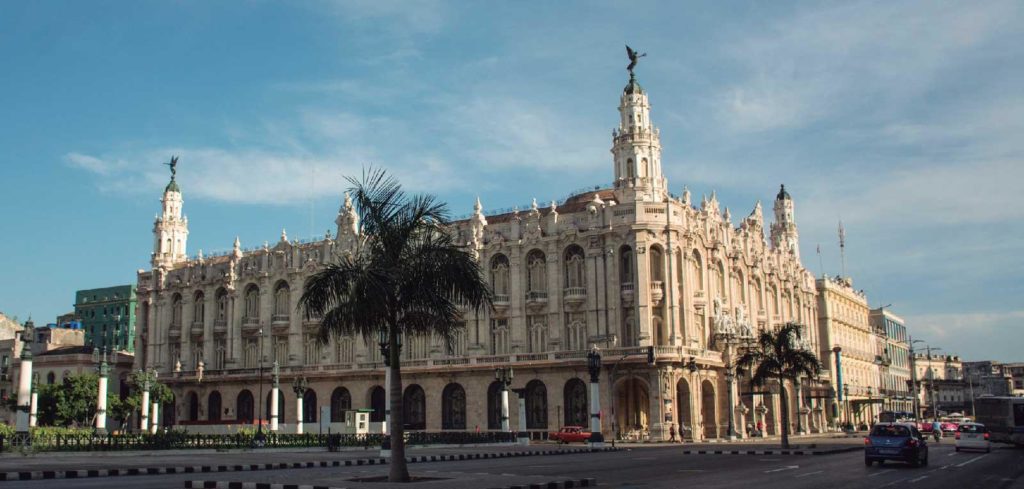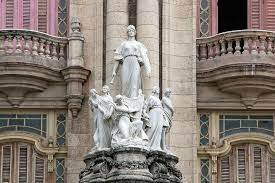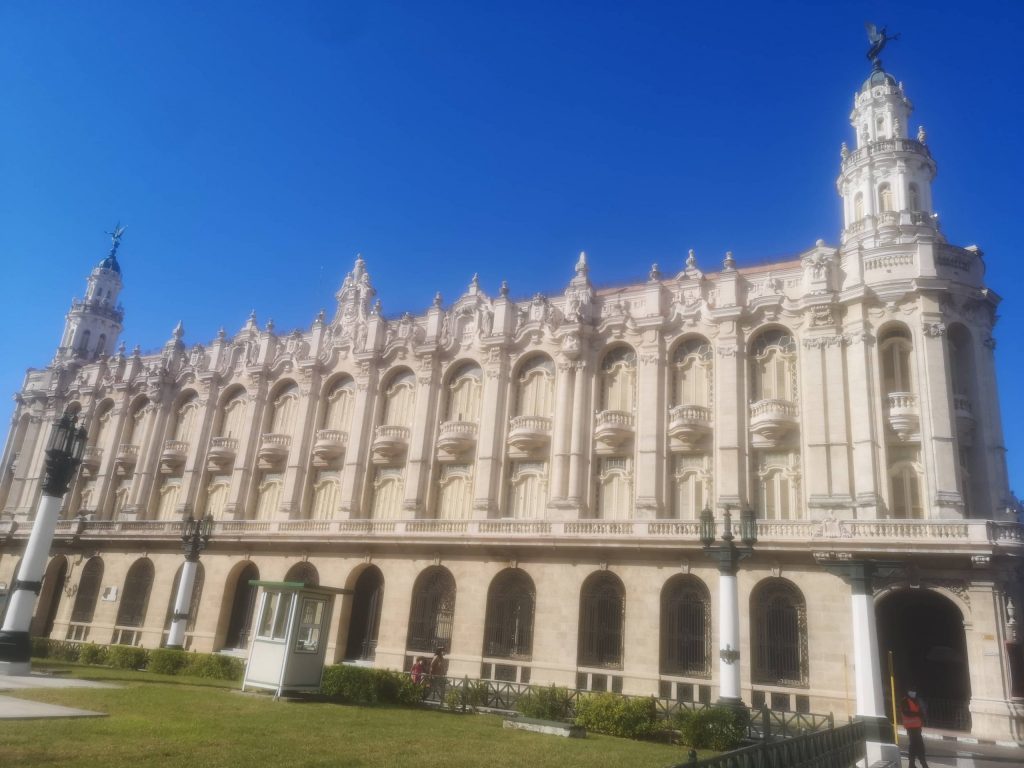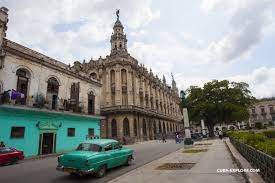EL CENTRO GALLEGO, LA HABANA, MAJESTUOSO (CONFISCADO) EDIFICIO PERO QUE SIGUE EN PIE EN EL CORAZÓN DE LA CAPITAL. PHOTOS
El Centro Gallego de La Habana. En el corazón de La Habana, en el Paseo del Prado (José Martí), frente al Parque Central y ubicado entre el Capitolio y el histórico Hotel Inglaterra, se alza majestuoso e imponente el Centro Gallego de La Habana.
El Centro Gallego de La Habana fue la solución a la creciente pujanza que había acumulado esta comunidad de emigrantes. Sus orígenes se remontan a 1906 cuando se tomaron el Teatro Nacional (antiguo Teatro Tacón) y los terrenos colindantes al mismo, hasta completar toda la manzana. Una vez que la sociedad Centro Gallego se hizo cargo del terreno, procedió a diseñar un conjunto que, además del teatro, contaría con dos salones de baile, un casino, salas de juego, oficinas, caja de ahorros, tesorería, restaurantes y cafeterías. La firma escogida fue Purdy & Henderson, muy presente en las principales obras del periodo republicano en el país, ya que también construyeron el Capitolio, el Hotel Nacional, el Hotel Plaza, el Centro Asturiano, el Banco Nacional, la Lonja de Comercio y el CMQ Radiocentro (actual Cine Yara).
Su construcción fue costeada por los inmigrantes gallegos de La Habana para que sirviera como centro comunitario-social.
Al triunfo de la Revolución castrista en 1959 fue confiscado. Es sede del Festival Internacional de Ballet de La Habana cada dos años desde 1960.
CONSTRUCCION DEL CENTRO GALLEGO, LA HABANA, CUBA
Entre los lugares de contenido histórico del Paseo del Prado, se encuentra la manzana entera entre San José y San Rafael; entre el Capitolio y el Hotel Inglaterra. En ese sitio se inauguró el 15 de abril de 1838 el teatro más importante de la capital y uno de los más grandes del continente, El Tacón, y en 1914 se construyó sobre toda la manzana el palacio Gallego Centro de La Habana. Obra del arquitecto belga Paul Beleu y fue construida en estilo neobarroco, su fachada principal cuenta con 4 esculturas de mármol blanco que representan alegorías de la caridad, la educación, la música y el teatro, diseñadas por Giuseppe Moretti. Los elementos se colocaron de manera equilibrada, balcones, ventanas, cornisas, la proporción de sus torres y molduras logran un ritmo elegante. Su teatro fue construido en el hermoso edificio y durante muchos años fue el más grande y lujoso de Cuba.
Desde sus inicios en 1880 dejó entrever sus prioridades, pues nació con 3 secciones: “Recreación y Adorno”, “Declamación” e “Instrucción”, esta última a cargo de una escuela de educación general, lengua y biblioteca que ya se ocupaba de 109 estudiantes en 1881 a pesar de tener solo 701 socios del Centro. Pronto creó una sección “Lírica” y otra “Filarmónica” con folk comprometido y se hizo cargo de lo que quedaba del coro “Ecos de Galicia”.
En 1907 se colocó la primera piedra del edificio-plaza. En 1913 se terminaron las obras del Teatro Palacio Social y en 1915 se concluyó. Actualmente mantiene el nombre de “Campus Concepción Arenal” que abarca clases primarias y clases nocturnas de costura, oficio, taquigrafía, etc. También mantiene una “Academia de Bellas Artes” y una “Academia de Música” elevada a Conservatorio Nacional.
Tras el triunfo del proceso revolucionario de 1959 el Centro Gallego y otros edificios construidos con el esfuerzo y aporte de los españoles emigrados en Cuba fueron confiscados y convertidos en organizaciones nacionales, cultura.
El Centro Gallego pasó a la administración de Alicia Alonso con el nombre de Gran Teatro Ballet y Ópera de Cuba. En 1978, el teatro, nuevamente remodelado con motivo de la celebración en Cuba del XI Festival Mundial de la Juventud y los Estudiantes, tenía una capacidad de 1556 butacas.
THE GALICIAN CENTER (CENTRO GALLEGO), LA HABANA, MAJESTIC (CONFISCATED) BUILDING BUT STILL STANDING IN THE HEART OF THE CAPITAL. PHOTOS
The Galician Center of Havana. In the heart of Havana, on the Paseo del Prado (José Martí), opposite Central Park and located between the Capitol and the historic Hotel Inglaterra, stands majestic and imposing the Galician Center of Havana.
The Centro Gallego de La Habana was the solution to the growing strength that this community of emigrants had accumulated. Its origins date back to 1906 when they took over the National Theater (former Tacón Theater) and the land adjacent to it, until they completed the entire block. Once the Centro Gallego society took over the land, it proceeded to design a complex that, in addition to the theater, would have two ballrooms, a casino, game rooms, offices, a savings bank, a treasury, restaurants, and cafes. The firm chosen was Purdy & Henderson, very present in the main works of the republican period in the country, since they also built the Capitol, the Hotel Nacional, the Hotel Plaza, the Asturian Center, the National Bank, the Lonja de Comercio and the CMQ Radiocentro (current Yara Cinema).
At the triumph of the Castro Revolution in 1959 it was confiscated. It hosts the International Ballet Festival of Havana every two years since 1960.
Its construction was paid for by the Galician immigrants of Havana to serve as a community-social center.
Among the places of historical content of the Paseo del Prado, is the full block between San Jose and San Rafael, between the Capitol and the Hotel Inglaterra. On that site was inaugurated on April 15, 1838 the most important theater in the capital and one of the largest on the continent, El Tacón, and in 1914 was built on the whole apple’s palace Galician Center of Havana. Work of the Belgian architect Paul Beleu and was built in neo-baroque style, its main facade has 4 white marble sculptures representing allegories of charity, education, music and theater, designed by Giuseppe Moretti. The items were placed in a balanced way, balconies, windows, cornices, the proportion of its towers and trim unit achieved an elegant pace. His theater was built in the beautiful building and for many years was the largest and most luxurious in Cuba.
Since its inception in 1880 hinted its priorities, because she was born with 3 sections: “Recreation and Adorno”, “Declamation” and “Instruction”, the latter in charge of a school of general education, language and library that already took care of 109 students in 1881 despite having just 701 Center partners. He soon created a section “Lyric” and another “Philharmonic” with committed folk and took over what was left of the choir “Ecos de Galicia”.
In 1907 the foundation stone of the building-seat was placed. In 1913, work was completed on the Social Palace Theatre and in 1915 was concluded. By now kept called “Campus Concepción Arenal” covering primary classes and evening classes in sewing, trade, shorthand, etc. Also maintained a “Academia de Bellas Artes” and “Music Academy” elevated to National Conservatory.
After the triumph of the revolutionary process of 1959 the Galician Center and other buildings built with the effort and contribution by the Spaniards emigrated in Cuba were confiscated and converted into national organizations, culture.
The Galician Center went under the administration of Alicia Alonso with the name of Grand Theater Ballet and Opera de Cuba. In 1978, the theater, revamped again on the occasion of the celebration in Cuba of the XI World Festival of Youth and Students, had a capacity of 1556 seats.
Agencies/ Wiki / CentroGallegoHis. / Extractos/ Excerpts/ Internet Photos/ Arnoldo Varona/ www.TheCubanHistory.com
THE CUBAN HISTORY, HOLLYWOOD.



 THE GALICIAN CENTER (Centro Gallego), Havana, Majestic (Confiscated) Building but Still Standing in the Heart of the Capital. PHOTOS. * EL CENTRO GALLEGO, Habana, Majestuoso (Confiscado) Edificio pero que sigue en Pie en el Corazón de la Capital. PHOTOS.
THE GALICIAN CENTER (Centro Gallego), Havana, Majestic (Confiscated) Building but Still Standing in the Heart of the Capital. PHOTOS. * EL CENTRO GALLEGO, Habana, Majestuoso (Confiscado) Edificio pero que sigue en Pie en el Corazón de la Capital. PHOTOS.






